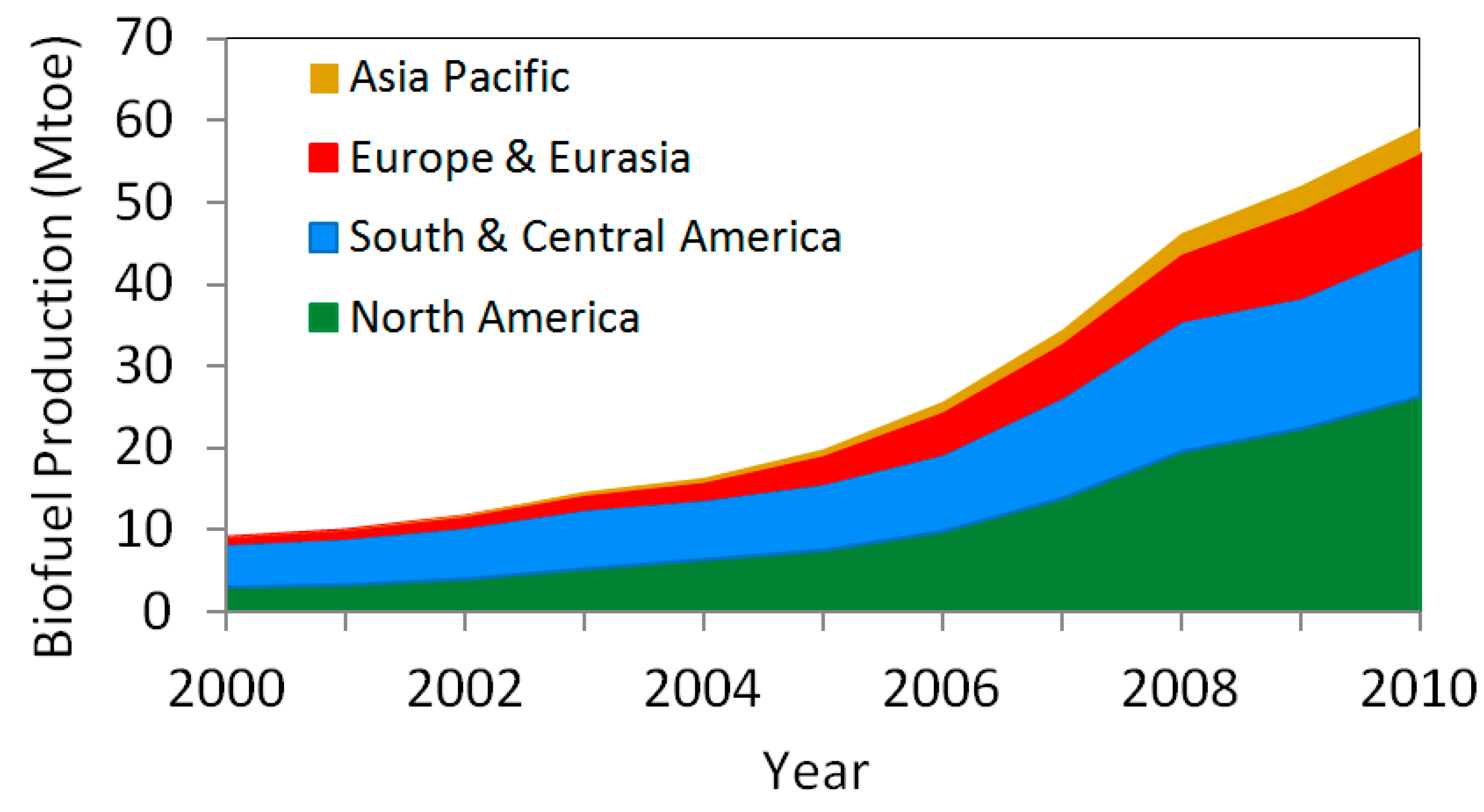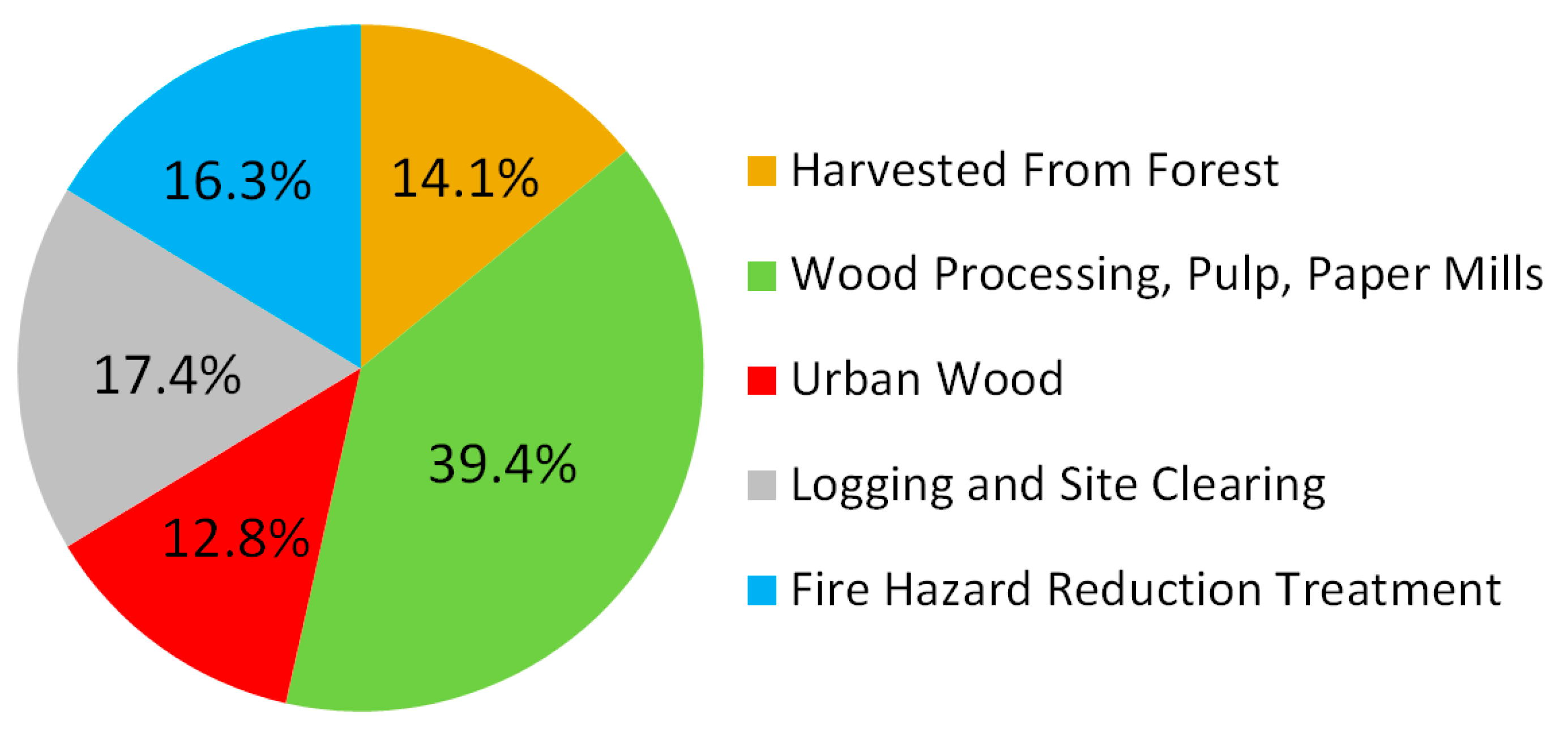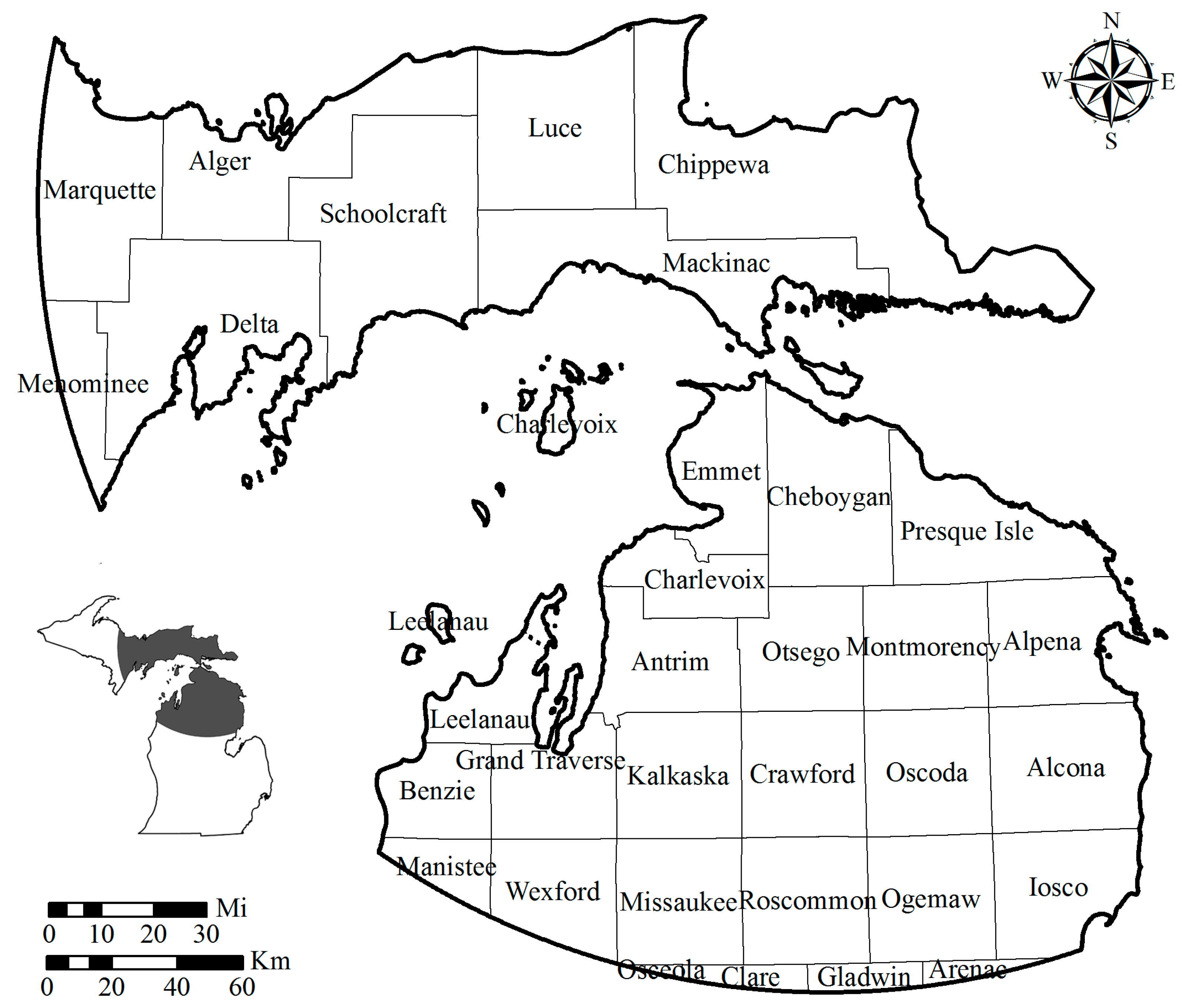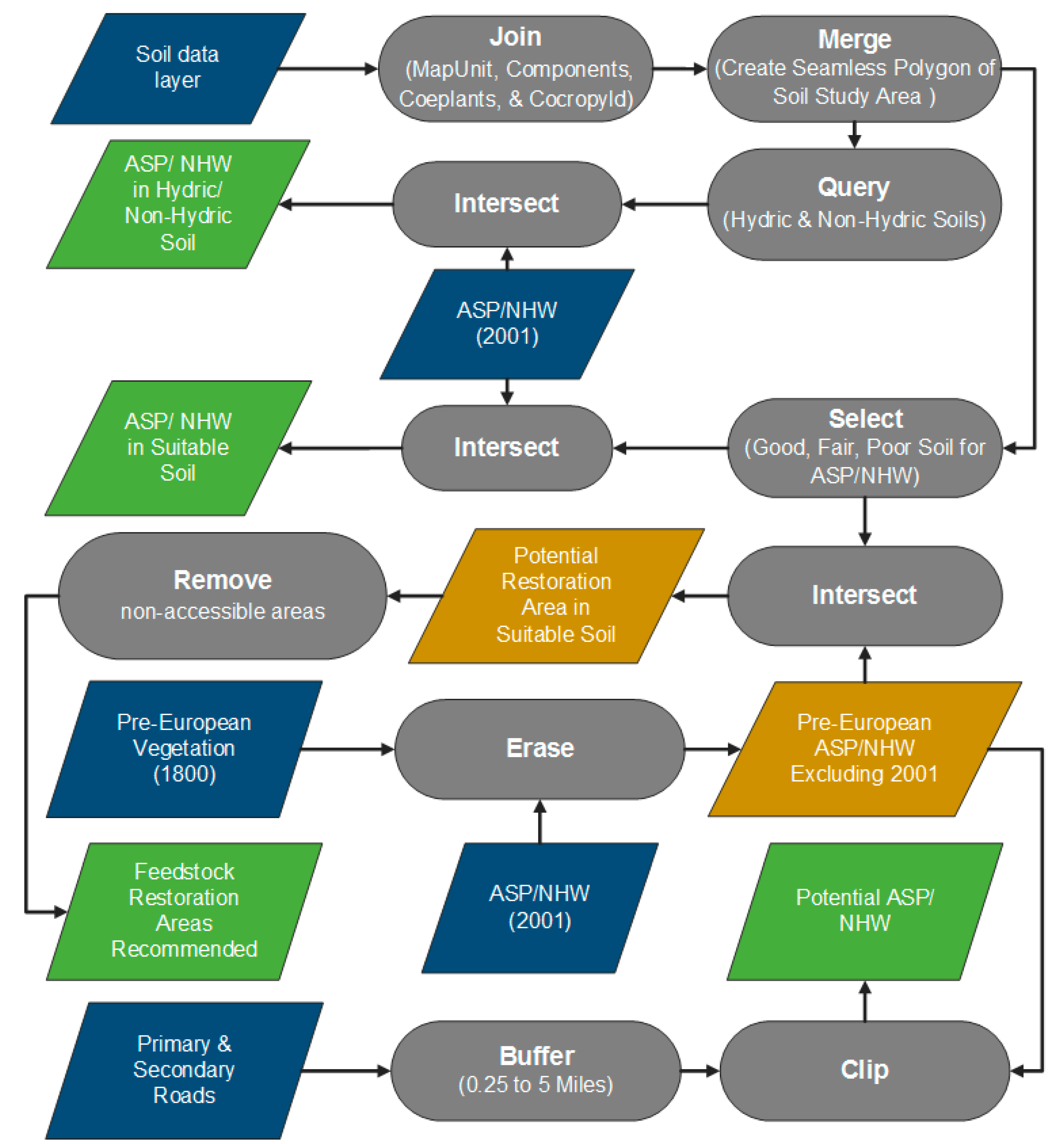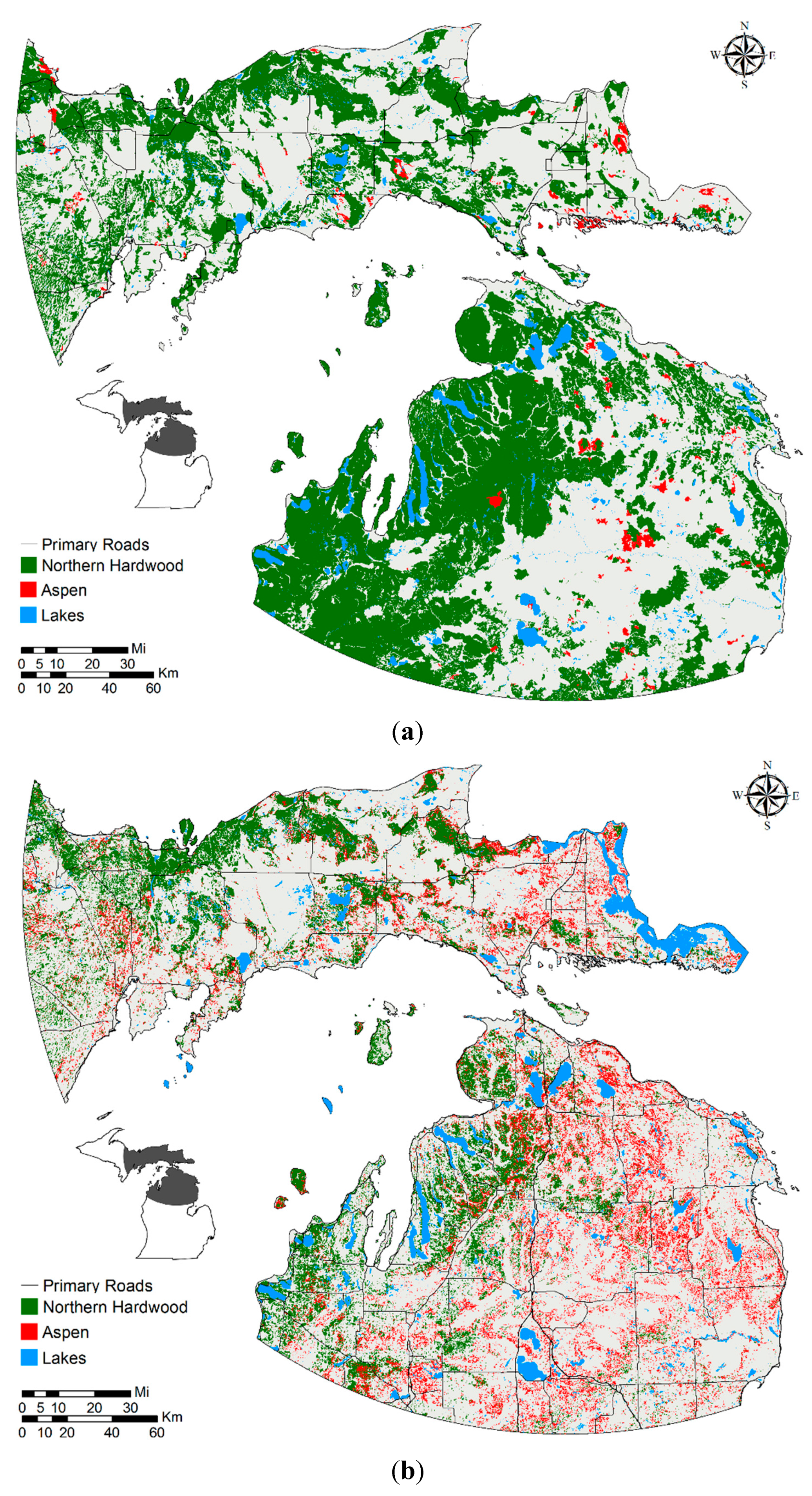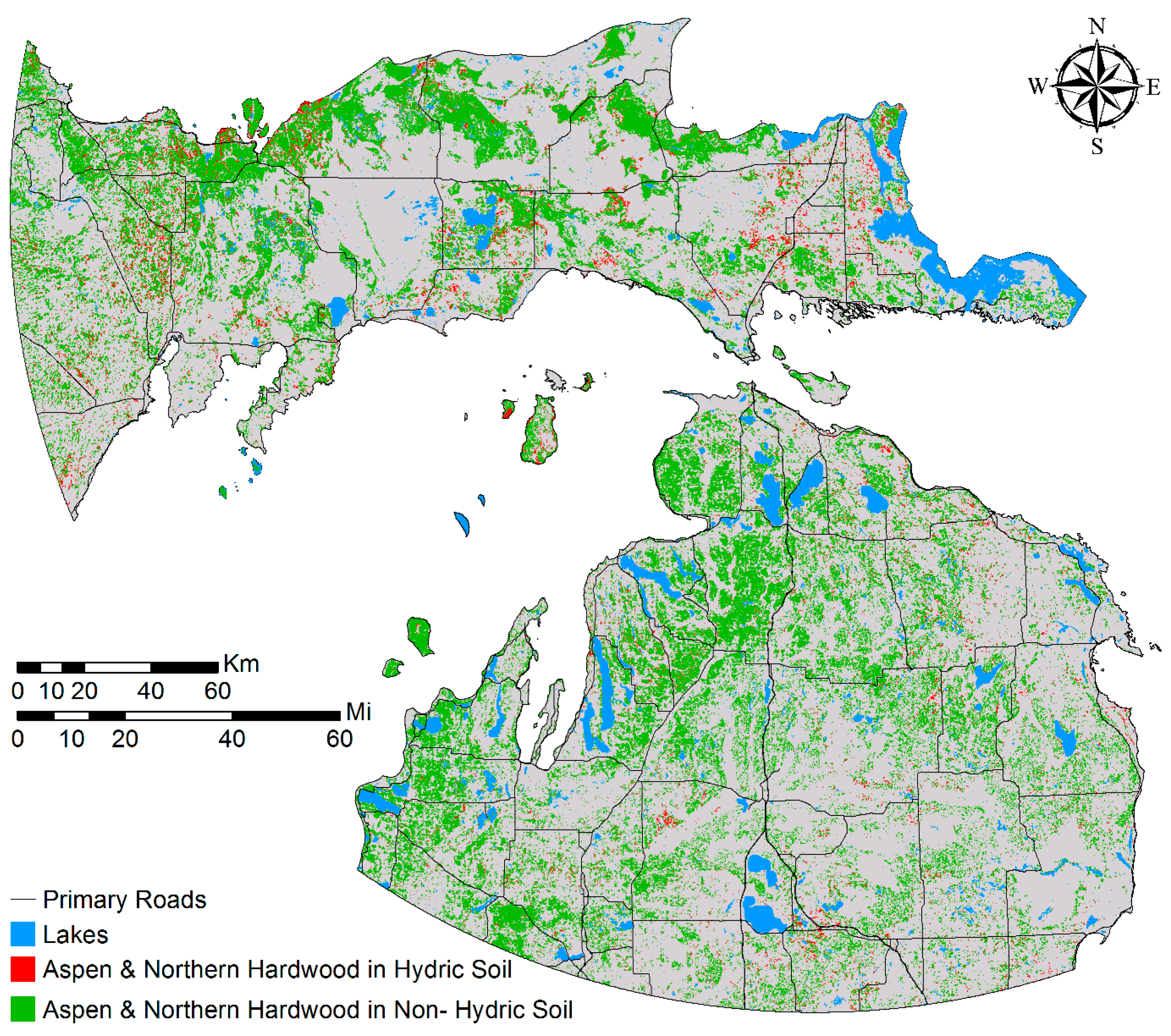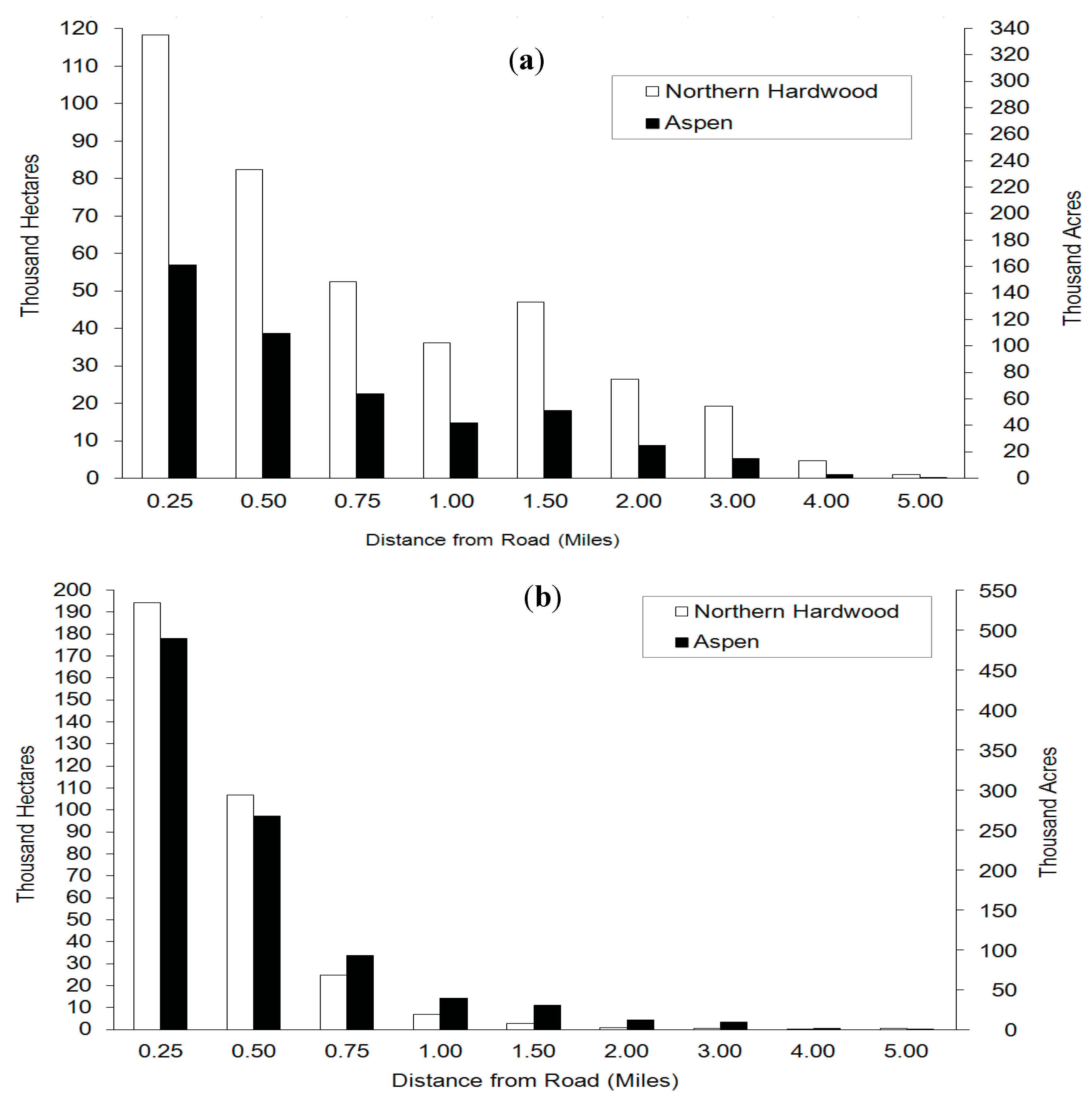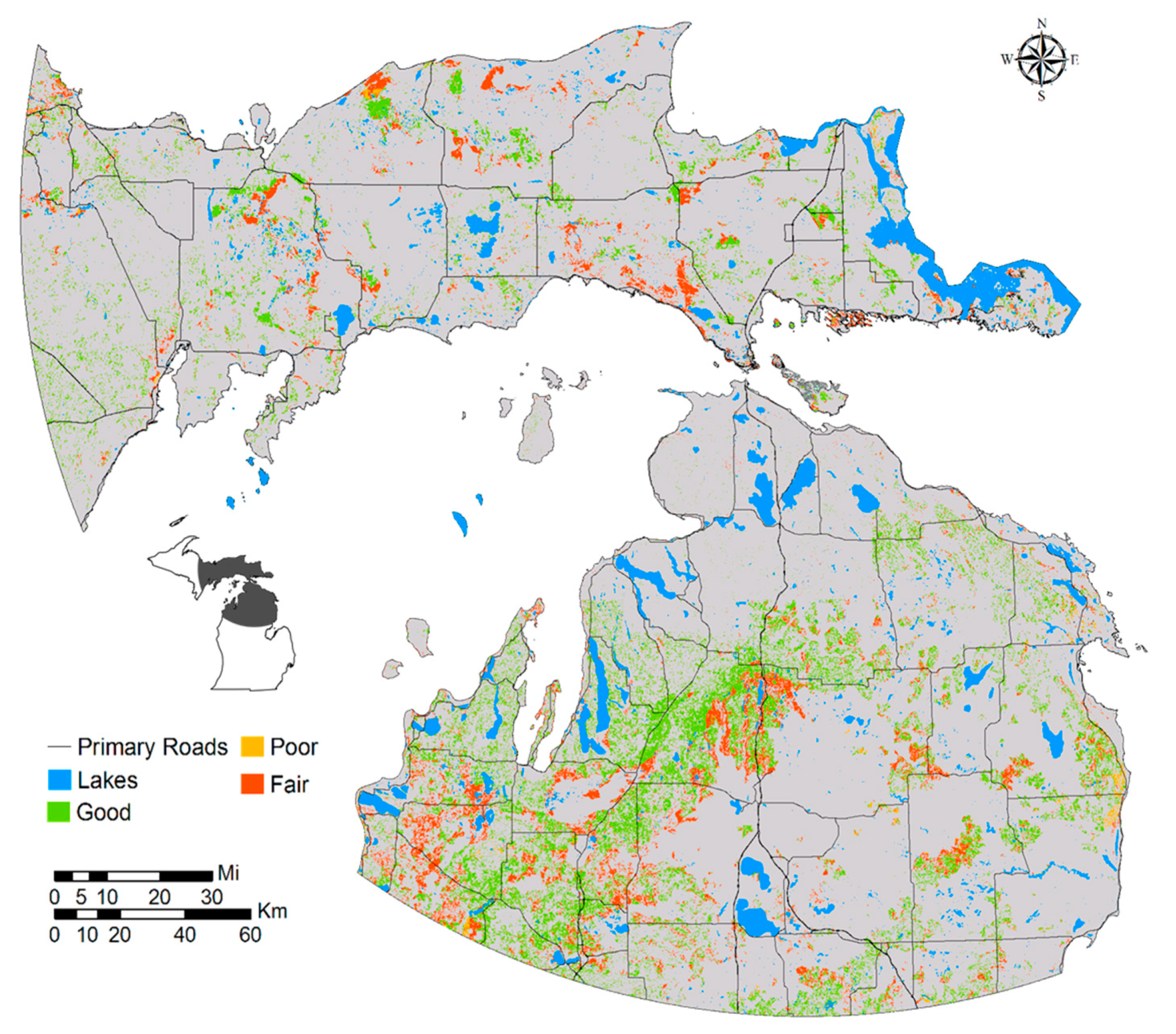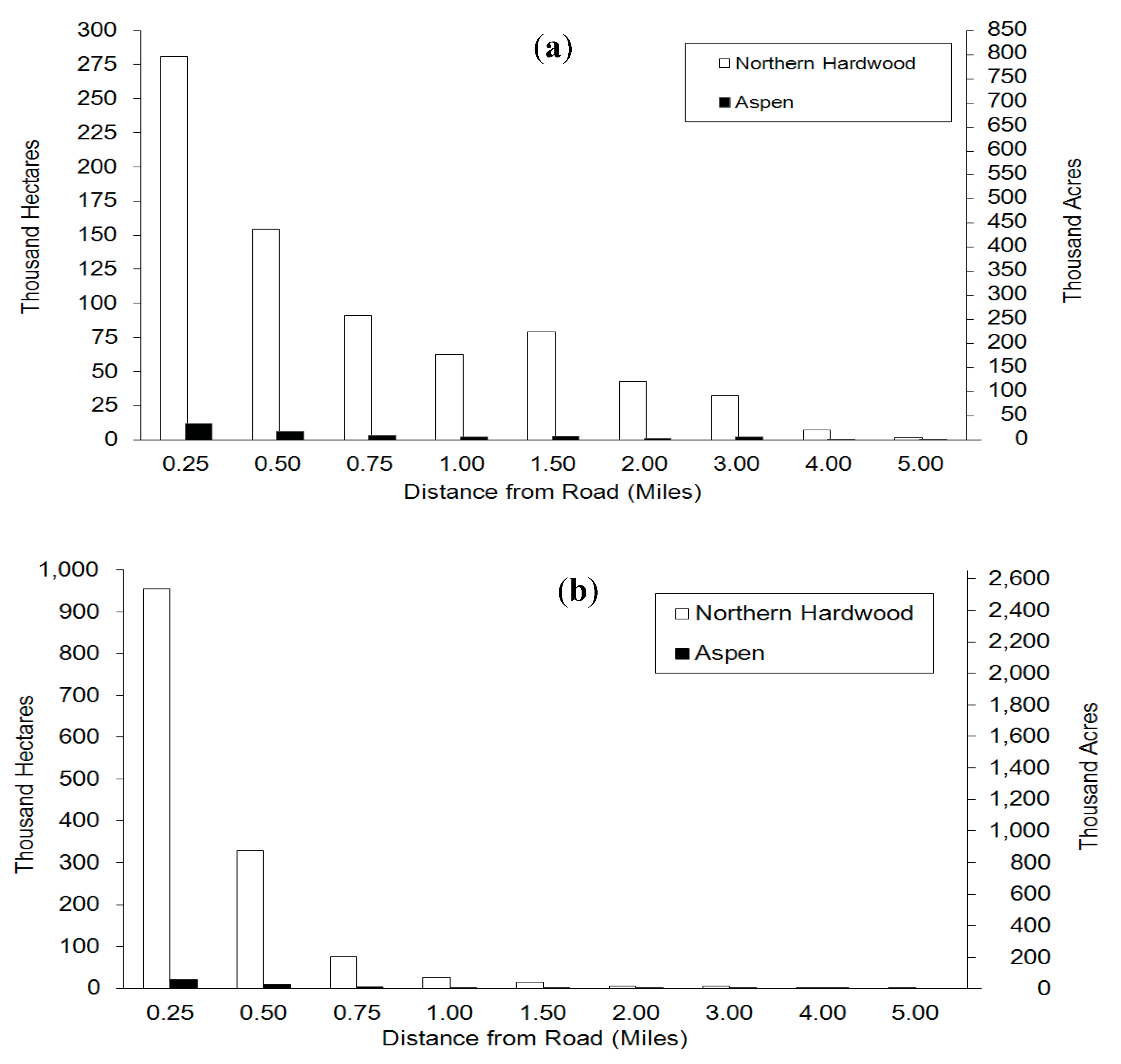1. Introduction
Producing sufficient energy and transitioning to non-fossil fuel energy sources is of growing concern, given issues of energy security and global climate change. Current global energy consumption is dominated by fossil fuels (oil, gas, and coal). Nonrenewable energy resources are believed to be limited [
1], and some predict world oil production will peak around 2030 if the current global energy portfolio holds into the future [
2,
3,
4]. Hence, new policies and incentives to develop sustainable energy sources and increase their utilization are under development [
5]. Interestingly, high oil production forecasts by the International Energy Agency (IEA), the United States’ Energy Information Administration (EIA), and the Organization of Petroleum Exporting Countries (OPEC) suggest that peak oil production is not a serious threat [
4]. However, energy security is increasingly an overarching concern since major oil production occurs in many countries experiencing political instability. Therefore, to improve energy security, the world needs to spend time and financial resources to diversify the global energy portfolio. However, global energy transition will be challenging since industrial and economic processes depend highly on fossil fuels and their byproducts.
In addition, developing renewable energy resources is important due to global climate change. There is extensive evidence that the world is becoming warmer [
6]. Since fossil fuels have large carbon footprints, it is critical for global energy policies to focus on lower carbon footprint energy sources such as solar, wind, hydropower, and biofuels. Biofuels are viewed by many as a viable renewable energy source which can be used in the primary energy mix, particularly in the transportation fuel and electricity generation sectors [
7,
8]. Thorough investigations into the potential of replacing fossil fuels with biofuels are needed before substantial changes in energy policies can occur [
9].
The use of transportation fuels derived from biomass has been projected to increase by more than 400% by 2035 [
10]. Energy production from biofuels doubled between 2000 and 2005, and further increased up to six times between 2005 and 2010 (
Figure 1). North, South and Central America are the major producers of biofuels. Proponents of biofuels attribute a number of benefits to this energy source including low greenhouse gas (GHG) emissions, improving local energy security and trade balances, and creating opportunities for socio-economic development in rural areas. However, a key factor constraining the use of biomass for energy production is resource availability and sustainability [
1]. Furthermore, the choice of feedstock species grown and harvested will determine biomass yield, which is critical for the long term economic viability of production facilities [
11]. As a result of these concerns, present and future amounts of local and regional woody feedstock availability need to be better understood before biofuels’ share in the energy portfolio can be projected realistically.
From a historical standpoint, most countries relied heavily on woody biomass to meet their energy needs. In the United States in 1880, almost 60% of energy came from wood. However by the mid-19th century, fossil fuels replaced woody biomass due to their high energy intensity, and ease of transportation and use [
12]. Recent biofuels research findings are setting the stage for reintroduction of woody biomass as a key energy source. For example, Bartle and Abadi [
3] demonstrated the superiority of second generation feedstocks (woody crops) to first generation feedstocks (sugar, starch and vegetable oils) by illustrating their lower effective cost, sustainability and environmental impacts. Furthermore, first generation biofuel feedstocks are also used as food crops, creating potential competition between uses [
9]. Wood chips are likely a better resource of ethanol as compared with other green resources such as corn, sugarcane, soy,
etc. because of a lower GHG footprint [
5].
Figure 1.
Biofuel production between 2000 and 2010 (Source of data: BP [
13]).
Figure 1.
Biofuel production between 2000 and 2010 (Source of data: BP [
13]).
Over the last 35 years, major changes in energy policy and economy have led the energy market to use wood energy as a competitor with traditional coal-fired and natural gas electricity generation. Applying a life cycle analysis to compare carbon emission of wood pellet firing and coal generating stations in Ontario, Canada, Zhang
et al. [
14] found that carbon emissions of coal generating stations are more than 10× greater than that of wood pellet firing plants. However, large scale net carbon emission reductions for generating power from wood residues may be achievable only in the long run rather than short term [
15].
In the United States, a sustainable supply of biomass for biofuel production is strategically important because biomass is currently the only renewable source of liquid transportation fuels. About one-third of the United States’ current transportation fuel could be produced from 1366 million dry tons of biomass [
16]. Forestlands cover about one-third of the United States (approximately 303 million ha), of which two-thirds is timberland with private (58%) or industrial (13%) ownership. About 10% of the forestland is used for non-timber uses and another 23% is classified as low productivity areas [
17]. The United States has the potential to meet about 30% of its transportation fuel demand from various biomass sources (
Figure 2), including residues from wood processing mills, pulp and paper mills, urban wood, logging residues, site clearing operations, and fuel treatment operations to reduce fire hazards [
16].
In Michigan’s Upper Peninsula (UP) and northern Lower Peninsula (LP) there is considerable potential for producing biofuels from feedstock sources such as aspen, hybrid poplar and hybrid willow (
Populus spp.), and northern hardwoods, particularly since the current rate of growth of aspen and northern hardwoods exceeds the amount harvested.
Table 1 shows several facilities in Michigan that produce electric power from wood fuel [
14].
Figure 2.
The United States’ woody feedstock sources (Source of data: US Billion Ton [
16]).
Figure 2.
The United States’ woody feedstock sources (Source of data: US Billion Ton [
16]).
Table 1.
Wood fuel electric power production facilities in Michigan (Source of data: Forestry Biofuel Statewide Collaboration Center (FBSCC) [
18]).
Table 1.
Wood fuel electric power production facilities in Michigan (Source of data: Forestry Biofuel Statewide Collaboration Center (FBSCC) [18]).
| Plant | Location | Production Capacity (kW) | Wood Consumption (tons/yr) |
|---|
| Hillman Power Co. | Hillman | 20,000 | 230,000 |
| Viking Energy/Lincoln Power | Lincoln | 18,000 | 150,000 |
| Cadillac Renewable Energy | Cadillac | 39,600 | 375,000 |
| Viking Energy/McBain Power | McBain | 18,000 | 150,000 |
| Genesee Power Station | Flint | 39,500 | 300,000 |
| Grayling Generating Station | Grayling | 38,000 | 250,000–300,000 |
Geographic Information Systems (GIS) have been used extensively around the world to provide valuable baseline information to support biofuel investment decisions [
19,
20]. To begin ensuring long term feedstock availability and sustainability, it is important to gain an understanding of the spatial distribution of the current feedstock, its location relative to the road network for harvesting accessibility, general land ownership, and changes in land use/cover patterns with reference to natural or undisturbed condition. The use of GIS facilitates incorporation of disparate spatial datasets in bioenergy feasibility and feedstock production assessment, including agricultural, economic, biophysical, and infrastructural data [
21,
22,
23] to determine feedstock land availability and estimate biomass for energy production [
24,
25]. Furthermore, GIS-based decision support tools have been developed to evaluate the transportation cost of energy crop feedstock and associated environmental implications [
26,
27,
28,
29,
30,
31], which are crtical for bioenergy production planning. These applications of GIS in the bioenergy planning literature have not incorporated historical land use conditions to guide site availability of bioenergy feedstocks, which is important for sustainable feedstock production while promoting native biodiversity.
The present study underscores the importance of changes in land use/cover patterns with reference to natural or undisturbed condition as a valuable source of information for feedstock development. A multi-faceted GIS-based approach has been developed to assess the current spatial extent of woody feedstocks, harvesting accessibility, and the potential for woody feedstock development based on information about pre-European settlement (circa. 1830) land cover in Michigan, the United States. The objectives of this research are to: (i) Determine the spatial distribution of aspen and northern hardwood forests and their proximity to appropriate transportation networks; and (ii) Compare current land use/cover to historic (pre-European settlement) extent to gain insight where underutilized land, such as abandoned agriculture fields, could potentially be restored to pre-European settlement conditions in order to increase long term feedstock availability while at the same time promoting diversity for native flora and fauna and meeting best management practice (BMP) guidelines. ArcMap 10.1 GIS is used to develop a spatial dataset in the form of a geodatabase and analyze the spatial distribution of aspen and northern hardwoods in the eastern UP and northern LP of Michigan.
4. Discussion
Site availability assessment is the first step in sustainable feedstock planning for bioenergy production, which should be complemented with techno-economic feasibility analysis of bioenergy conversion technologies [
20] and socio-ecological aspects of biomass resources management [
52].
Two critical questions are: where are existing feedstock sources located and where were the historical sites of these sources? Herein, we presented a GIS-based spatial analysis procedure to identify where current apen and northern hardwoods stands that can be used for bioenergy production are located in a Michigan study area while determining potential sites for future feedstock development based on pre-European settelement vegetation data, representing undisturbed land cover.
A significant amount of aspen and northern hardwoods has been converted to other land use and cover types since European settlement, and the scattering of aspen stands has increased. Furthermore, a significant amount of woody biomass is available in close vicinity of the existing road network, which can be effectively used as feedstock in the future.
Sustainability of timber supply under a scenario of increased harvest levels requires both site- and landscape-level considerations. While large landowners such as state, national forests, and large private commercial forests have effective resource planning methods, private lands owned by individuals or families often lack management plans and harvests across many private owners are uncoordinated. Hence, one of the next questions which needs to be addressed is evaluating stands located on private nonindustrial lands and working with these private landowners. Family forests account for 8.96 million acres in Michigan. Most family forests are less than 200 acres in size, with over half of them in parcels of 1 to 9 acres [
49]. It is likely that owners within the study have more lands skewed toward larger ownerships on average than statewide totals. Further, the owners are more likely to harvest timber due to more active timber markets and a culture more attuned to harvesting.
Previous applications of GIS in feedstock planning have not incorporated natural condition or undisturbed vegetation data to ascertain potential sites for feedstock source development or to implement Best Management Practices. The presented procedure can be exported to other study sites in the United States for application using spatial datasets available from federal and state GIS clearinghouses. Likewise, the approach can be applied in other countries where similar datsets of soils, road accessibility, land ownership, and natural vegetation conditions can be compiled to support feedstock development and vegetation restoration decisions.
5. Conclusions
Instability of production and the price of oil, as well as environmental concerns such as anthropogenic climate change necessitate efforts for expanding the global energy mix and increasing sustainable energy sources. The need for expanding biofuel production is increasing as the world prepares to diversify the global energy mix to increase security and sustainability of energy production. The Americas produce a large share of the world’s biofuel. The state of Michigan, with its vast feedstock sources hybrid poplar and hybrid willow (Populus spp.) is an area where biofuel production can be expanded. However, availability of sufficient feedstock sources and the potential for long-term feedstock production needs to be characterized to ensure long term feedstock supplies without environmental degradation. Understanding the spatial distribution of the current feedstock sources, in terms of area, soil characteristics, accessibility from roads and land ownership, is important for long-term feedstock production.
The study provides a spatial analysis procedure which identifies where current and potential stands are located. A GIS was developed to compile present day (2001) and pre-European settlement (circa. 1830s) land use/cover, soils, road infrastructure, and ownership data for the eastern part the UP and northern part of the LP. The land use change between pre-European settlement and 2001 was characterized, and suitable areas for aspen, northern hardwood or other woody biomass development were identified with respect to soil condition, land ownership, and proximity to roads. The results suggest a significant conversion of northern hardwoods to other land use/cover types since European settlement, and an increase in the scattering of aspen stands. The insights from this work provide a basis for expanding woody feedstock sources in the in the study area.
Significant increases in timber production beyond current or historic levels will likely raise questions about long-term sustainability of wood supplies, and protection of non-timber resources. Coordinated efforts among public and private interests to establish guidance on sustainable management will be needed if industrial wood utilization is increased.
